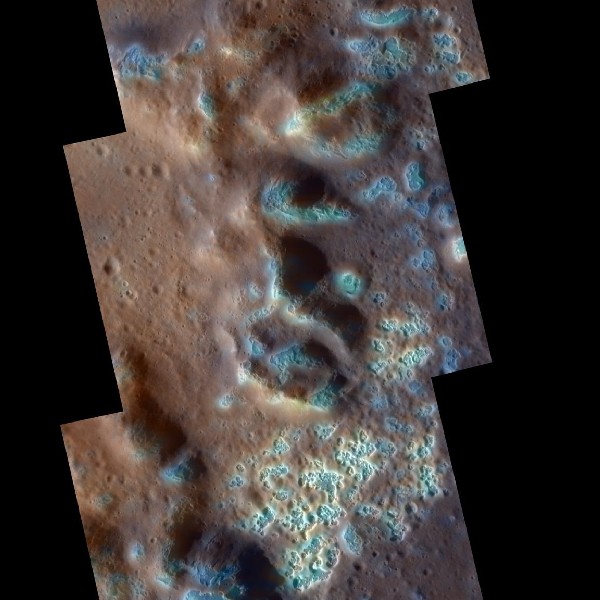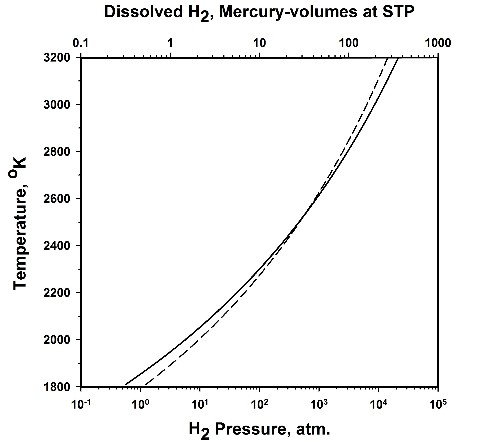

Mercury Hollows Explained by Hydrogen Geysers
 
Mercury Hollows Explained by Hydrogen Geysers |
 NASA’s Project MESSENGER spacecraft returned photos
of Mercury’s surface revealing “… an unusual landform on Mercury, characterized
by irregular shaped, shallow, rimless depressions, commonly in clusters and in
association with high-reflectance material” (image right). Mercury is the only
rocky planet where such surface-features have been observed. NASA scientists
recognized that the “pits” appear to have formed from volatile-related activity,
but were unable to explain the origin and composition of the volatile substance,
or the composition of the associated “high-reflectance material” on Mercury’s
surface.
NASA’s Project MESSENGER spacecraft returned photos
of Mercury’s surface revealing “… an unusual landform on Mercury, characterized
by irregular shaped, shallow, rimless depressions, commonly in clusters and in
association with high-reflectance material” (image right). Mercury is the only
rocky planet where such surface-features have been observed. NASA scientists
recognized that the “pits” appear to have formed from volatile-related activity,
but were unable to explain the origin and composition of the volatile substance,
or the composition of the associated “high-reflectance material” on Mercury’s
surface.
 In a scientific
communication published in the August 25, 2012 issue of Current Science,
J. Marvin Herndon describes “a basis of planetary formation, not considered by the
authors and unlike their cited models, and shows that primordial condensation
from an atmosphere of solar composition at pressures of one atmosphere or above
leads to the incorporation of copious amounts of hydrogen in Mercury’s core,
much of which is released as the core solidifies.” Further, Herndon posits
“release of hydrogen escaping at the surface … is responsible for the formation
... of pits, and for the formation of the associated ‘high-reflectance material’
… iron metal reduced from an iron compound, probably iron sulfide, by the
escaping hydrogen.”
In a scientific
communication published in the August 25, 2012 issue of Current Science,
J. Marvin Herndon describes “a basis of planetary formation, not considered by the
authors and unlike their cited models, and shows that primordial condensation
from an atmosphere of solar composition at pressures of one atmosphere or above
leads to the incorporation of copious amounts of hydrogen in Mercury’s core,
much of which is released as the core solidifies.” Further, Herndon posits
“release of hydrogen escaping at the surface … is responsible for the formation
... of pits, and for the formation of the associated ‘high-reflectance material’
… iron metal reduced from an iron compound, probably iron sulfide, by the
escaping hydrogen.”
In the article,
Herndon describes his calculations that show that when Mercury’s matter first
condensed from primordial gas, if hydrogen pressures exceeded about one
atmosphere, iron would condense as a liquid raining out to form Mercury’s core
before mantle silicates began to condense. As he points out, “hydrogen is
readily soluble in molten iron …” and he calculated that one or more Mercury
volumes of hydrogen (at STP) could dissolve in Mercury’s iron core. In the
figure at left, the solid line is the beginning of iron condensation; the dashed
line the volume of hydrogen that could dissolve in Mercury's core forming under
those conditions. For detail description, see paper cited below.
As Herndon reveals
in the article, “The release of dissolved hydrogen during Mercury’s core
solidification is … certainly sufficient in amount to account for the ‘unusual
landform’ on Mercury’s surface and is possibly involved in the exhalation of
iron sulfide, which is abundant on the planet’s surface, and some of which may
have been reduced to iron metal thus accounting for the associated
‘high-reflectance material’, bright spots.”
The article further
describes a test with potentially profound implications on planetary formation.
“Verifying that the ‘high-reflectance material’ is indeed metallic iron will not
only provide strong evidence for Mercury’s hydrogen geysers, but more generally
will provide evidence that planetary interiors ‘rained out’ by condensing at
high pressures within giant-gaseous protoplanets” rather than by the NASA
planetesimal version that begins with the assumption of dust condensing at low
pressures and then gathering progressively into larger objects, ultimately
forming planets that would require whole-planet melting to form cores.
Important Paper: Herndon, J. M., Hydrogen geysers: explanation for observed evidence of geologically recent volatile-related activity on Mercury's surface. (click here) Current Science, 2012, 103, 361-362.